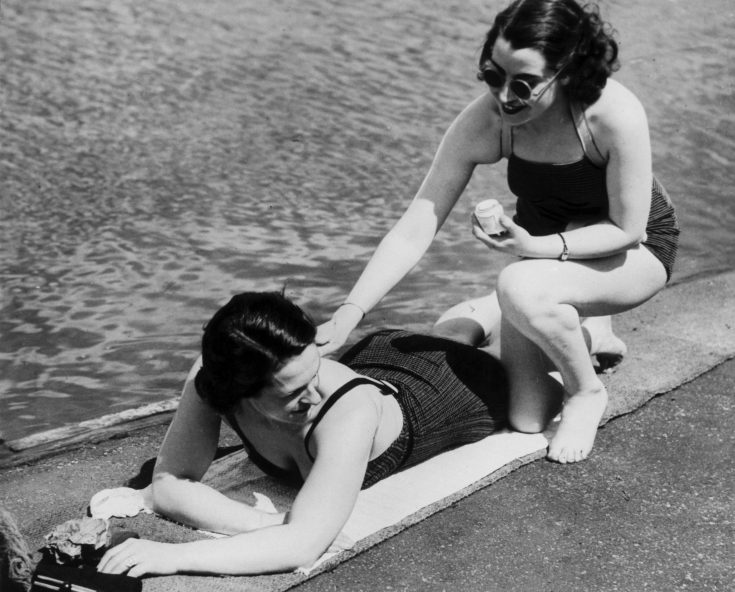Sun cream season is very much upon us.
Once-a-Day, UVA, UVB, spray, oil, cream, non-greasy, SPF, high, low, absorbent, reflective, sport, vegan, bronzing, water resistant, anti-aging; from Gwyneth Paltrow’s favourite to Aldi’s own brand…
As if the threat of skin cancer and the pain of sun burn wasn’t enough, we must navigate through this bewildering maze of products, prices and promises. How did sun protection become a multi-billion-pound market?

Like most things, sun protection products find their origin in antiquity, where a variety of plants and minerals were used on skin, to reflect UV rays, such as calcite powder and clay – like the white minerals, titanium dioxide and zinc oxide, found in modern sun creams.
It wasn’t until the late 1920s that the first synthetic chemical sun protection arrived on the (US) scene, an emulsion of benzyl salicylate and benzyl cinnamate, though a mass market for such a product had not quite arrived yet.
In the early twentieth century ‘sunning oneself’, as it was then called, was a medically-prescribed activity – UV rays promoted by physicians as therapies for tuberculous and rickets.
By the 1930s sunbathing had become a popular pastime for pleasure seekers. Some have credited Coco Chanel with starting a trend for tanning, after she got accidentally sunburnt in 1923 on a cruise to Cannes.
Nevertheless, the French Riviera would be the setting for the birth of the first commercial suntan lotion.

Eugene Schueller, the founder of cosmetics giant L’Oréal, was a fair-skinned chemist with a penchant for sailing. Failing to devise himself a successful formula to combat his frequent sunburn, he tasked the chemists of L’Oréal laboratories with the job.
In April 1935 they presented him with a ‘sun oil’ that contained benzyl salicylate as the active ingredient, the same chemical used in the first chemical sunscreen of 1928.
Widely used in the cosmetics industry as a component of perfumes, benzyl salicylate works by absorbing, or filtering out, UVB light, the radiation that causes the skin to burn.
Two months later Schueller launched the product on the Riviera under the name ‘Ambre Solaire’. Its iconic brown, indented bottle was marketed through posters depicting tanned bodies of women.

Ambre Solaire tapped into an aspirational ideal, based on the earlier medical notions, that a tanned body was a healthy one. Its associations with the French Riviera and affluent beach holidays, as well as the (gendered) use of models, presented the product as part of a luxury lifestyle.
Sun tan oils, like Ambre Solaire, Piz Buin and the US Coppertone brand, were intended to encourage tanning without a burn. It was not until the 1970s that the market shifted towards ‘sun protection’, as the link between sun exposure and skin cancer was becoming more publicly known.

In 1974 Franz Greiter, Austrian chemist and founder of Piz Buin, introduced the term ‘sun protection factor’ or SPF, which is a formula to determine the fraction of UVB light that will reach the skin over time. For example, if a person were to burn without sun protection after 5 minutes of sun exposure, SPF 10 would protect the same person in the same exposure for 50 minutes.
SPF does not take into account UVA rays, which although not responsible for sunburn, do also lead to skin cancer. Broad-spectrum modern suncreams contain protection against both UVA and UVB.
Among the most effective reflectors against UVA radiation are minerals like zinc oxide and titanium dioxide. The latter has been produced in huge quantities by the chemical industry since the early twentieth century as white pigment for paint.
Initially these minerals were used as a thick white paste in sunblock, but some modern sun creams now contain nano-particles, which mean they are both more effective and less paste-y.

Recently, there has been a fashionable trend towards ‘natural’, ‘clean’ and dermatological sun lotion, Gwyneth Paltrow-endorsed products are presenting titanium dioxide as novel minerals to the industry. But as this bottle of the stuff from the mid-1960s shows, it is nothing new under the sun.
Learn more about humanity’s relationship with our nearest star in this blog series, based on our recent exhibition The Sun: Living With Our Star.
